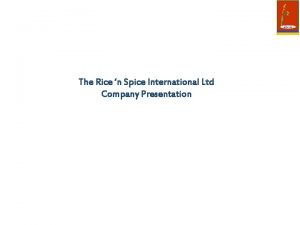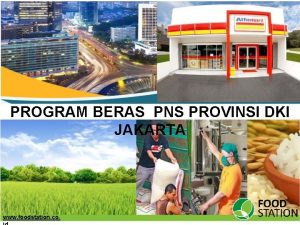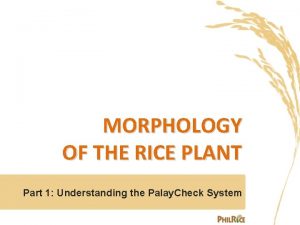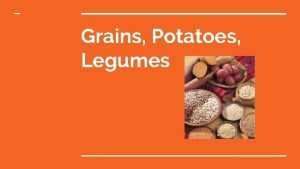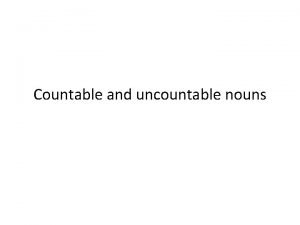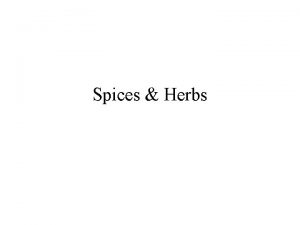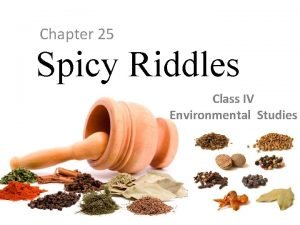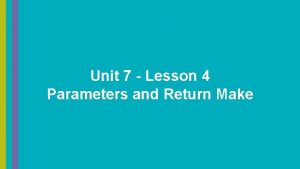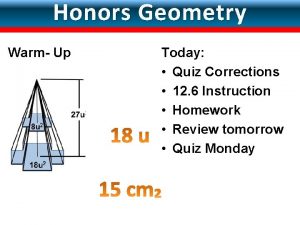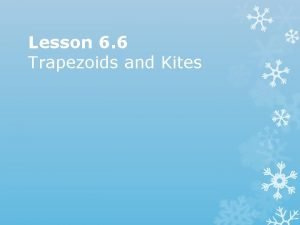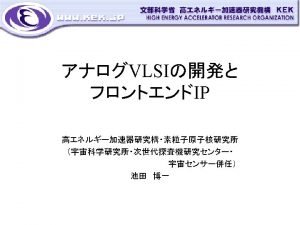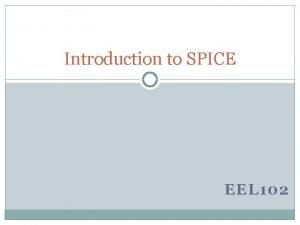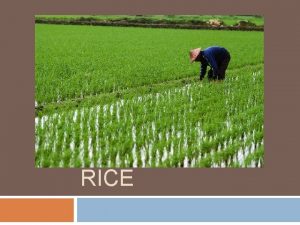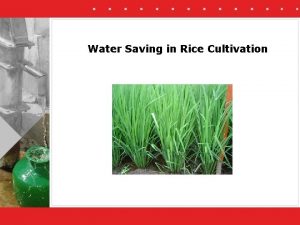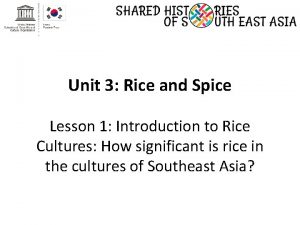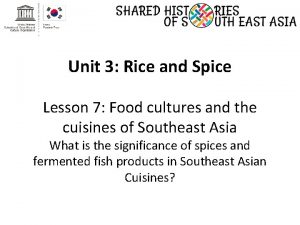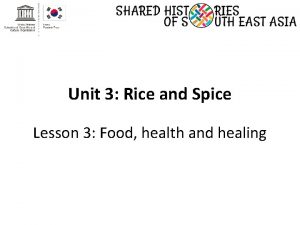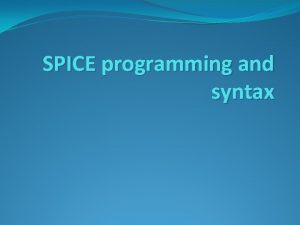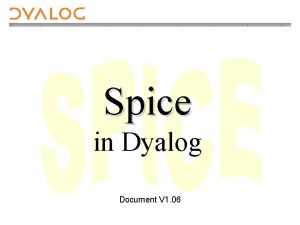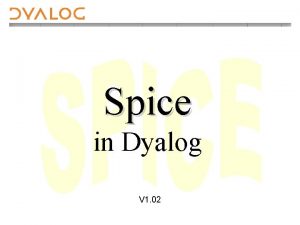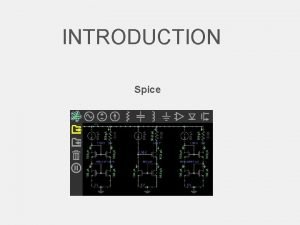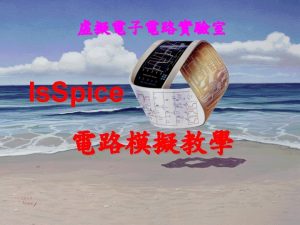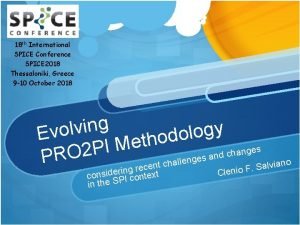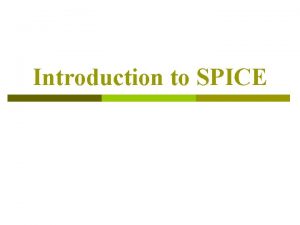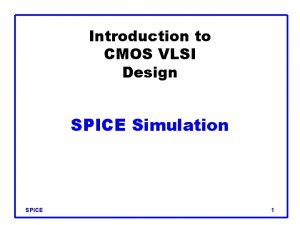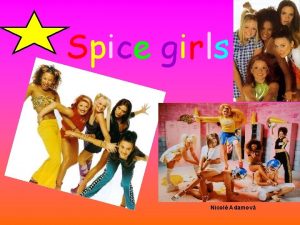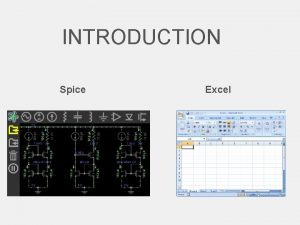Unit 3 Rice and Spice Lesson 5 Spice

























- Slides: 25

Unit 3: Rice and Spice Lesson 5: Spice, rice and the economic histories of Southeast Asia

A note to users of this presentation • This presentation was developed as complementary materials for teachers running this lesson. It follows the lesson plan. • It includes content from the lesson plans and the introductory essays for teachers’ lectures. It also introduces some of the activities suggested for students. • You are welcome to customize this presentation to adjust the lesson to their curriculum and to your students. You can change images, add/remove activities, and of course delete this slide, etc. The Teacher’s Guide (https: //sharedhistories. asia/teacher/) provides guidance on how to adjust the lessons. • We wish you a successful lesson! The Southeast Asian Shared Histories project was developed by UNESCO Bangkok with funding from the Republic of Korea.

What are these spices?

Discussion What spices do you use at home? What do you use them for? How important are spices in your lives?

Spices are important in world history: they were highly sought after commodities.

“God made Timor for sandalwood and Banda for mace and the Moluccas for cloves, and that this merchandise is not known anywhere else in the world except in these places. Tomé Pires* asked and enquired very diligently whether they had this merchandise anywhere else and everyone said not. ” * Tomé Pires was a Portuguese apothecary from Lisbon who avidly collected and documented information on the Malay. Indonesia area, and personally visited Java, Sumatra and Maluku.

Southeast Asian Archipelago - 15 th and 16 th century - one of the principal sources of spices.

World trade Spices led to trade, exploration and linkages between South-East Asia and the wider world (Europe, China, India, the Middle East and the Middle East).

The spice trade illustrates different types of connections: • between countries • between trade and politics, society and religion • between island mainland Southeast Asia • between Southeast Asia and the world.

Group work • Each group read 2 sources. • Based on the sources, explain how the spices were used by different groups of people in the sources. • Shares your findings with the class.

Conclusion Spices were desired: • for their aromatic properties • in cooking • in medical treatments. This desire for spices prompted exploration and trade between other parts of the world and Southeast Asia.

Discussion Why do you think maritime routes were used instead of overland routes?

For example • Maritime travel can be better planned because of the regular patterns of winds and monsoons. • Forested hinterlands are little populated and not suitable to host travellers. • Few roads are available. • High mountains may be difficult to cross, especially in winter season.

Trader with other countries European merchants -- initially the Portuguese, followed by the Dutch and English – acted as middlemen to bring the spices to their home markets. Source: Merchants from Brabant and Antwerp https: //en. wikipedia. org/wiki/Merchant#/media/File: 16 th_ce ntury_costumes_of_merchants_from_Brabant_and_Antwerp. jpg

The Ming Voyages of Cheng Ho (Zheng He), 1371 – 1433 In the early 15 th century, the Ming court dispatched seven major sea voyages under Admiral Cheng Ho. The voyages not only brought back spices from South-East Asia, but also gave rise to large-scale pepper cultivation in Sumatra for the China market

There were also numerous Arab merchants from the Middle East and Indian and traders from India and China. Arab and Persian merchants bought Moluccan products in western Indonesia on their way to China.

The Southeast Asians also participated actively in the spice trade, both as cultivators, growing spice trees as cash crops, and as merchants, shipping the harvests to regional ports. Source: https: //cilubintang. com/all-project-list/history-of-the-spice-trade/

Think – Pair - Share How do you think the spice trade transformed South-East Asia? What were some of the possible political, economic, social, cultural changes that occurred in South-East Asia due to the movement of people and goods?

Interconnections Ø Parts of Southeast Asia interacting with each other as a result of trade expansion Ø The region became increasingly connected to other parts of the world as well. This inter-connectedness also transformed Southeast Asian societies.

Gallery Walk • Several sources are displayed throughout the classroom. • In groups of 4, move around the room to read or observe each source. • Identify how were Southeast Asia societies transformed by the spice trade: politically, economically, socially and culturally. • Fill in your handout with your finding and the evidence you found. Politically in the source. Economically Socially and culturally Point: Evidence:

The spice trade give rise to a ‘Malay world’ of commerce in islands in South-East Asia. The trade encompassed the Malay-Indonesian archipelago, with large maritime trading zones in the Straits of Malacca, Java Sea and Sulu Sea.

Spice trade and urbanization The spice trade stimulated urbanization as well. Chinese, Indian, Arab and European traders, as well as those from different parts of Southeast Asia, gathered at ports in island Southeast Asia to conduct their businesses.

Spice trade and urbanization • Cities such as Melaka (Malacca), Makassar (Sulawesi) and Banten (Java) were large cosmopolitan centers with multicultural populations. • Although the different traders often used Malay as a lingua franca, but numerous languages were spoken in the port cities. • The Portuguese traveler Tomé Pires claimed that Melaka had 84 languages. Source: Gaspar Correia, Malacca in 16 th century https: //commons. wikimedia. org/wiki/File: Malacca_in_1511. png

Spice trade and religion expansion The spice trade introduced to Southeast Asia the world religions of Islam (in the archipelago) and Theravada Buddhism (on the mainland). As part of a worldwide expansion of Islam in the Middle East and India, Arab and Indian traders brought the religion to Southeast Asia. Being large urban centers, the port cities facilitated the conversion of their populations to the new religions. In turn, their rulers used Islam and Buddhism as the basis of their power. St. Paul's Church in Malacca Source: Bjørn Christian Tørrissen https: //commons. wikimedia. org/wiki/File: St. _Paul%27 s_Church_Malacc a_2012. JPG

Conclusion The spice trade illustrated different types of connections: between countries • between trade and politics, society and religion • between island mainland Southeast Asia • between Southeast Asia and the world The spice trade in Southeast Asia is not merely a story of regional history, but a showcase of global history due to the extent of connections cities of Southeast Asia had with each other and with other parts of the world.
 The rice n spice international ltd
The rice n spice international ltd Hyp opp adj
Hyp opp adj Beras pns dki
Beras pns dki Unit 6 review questions
Unit 6 review questions Morphology of rice plant
Morphology of rice plant Tillering stage of rice
Tillering stage of rice Potatoes legumes
Potatoes legumes Countable noun
Countable noun What is the difference between a spice and a herb
What is the difference between a spice and a herb Which spice looks like a nail
Which spice looks like a nail Chartch
Chartch Micro lesson plan time
Micro lesson plan time Sat vocabulary lesson and practice lesson 4
Sat vocabulary lesson and practice lesson 4 Lesson 1 thermal energy and the behavior of matter
Lesson 1 thermal energy and the behavior of matter Lesson 4 gravity and motion lesson review
Lesson 4 gravity and motion lesson review Lesson outline lesson 1 magnets and magnetic fields
Lesson outline lesson 1 magnets and magnetic fields Lesson outline lesson 3 eclipses and tides answer key
Lesson outline lesson 3 eclipses and tides answer key Unit 7 lesson 2 parameters and return investigate
Unit 7 lesson 2 parameters and return investigate Permutation with restrictions
Permutation with restrictions Lesson 1-1 variables and expressions answer key
Lesson 1-1 variables and expressions answer key Loanable funds graph recession
Loanable funds graph recession 12-6 surface areas and volumes of spheres answers
12-6 surface areas and volumes of spheres answers Kite definition in geometry
Kite definition in geometry Lesson 3 rational functions and their graphs
Lesson 3 rational functions and their graphs Lesson 6 anorexia nervosa and bulimia
Lesson 6 anorexia nervosa and bulimia Unit 1 introductory lesson 1- variables and expressions
Unit 1 introductory lesson 1- variables and expressions
